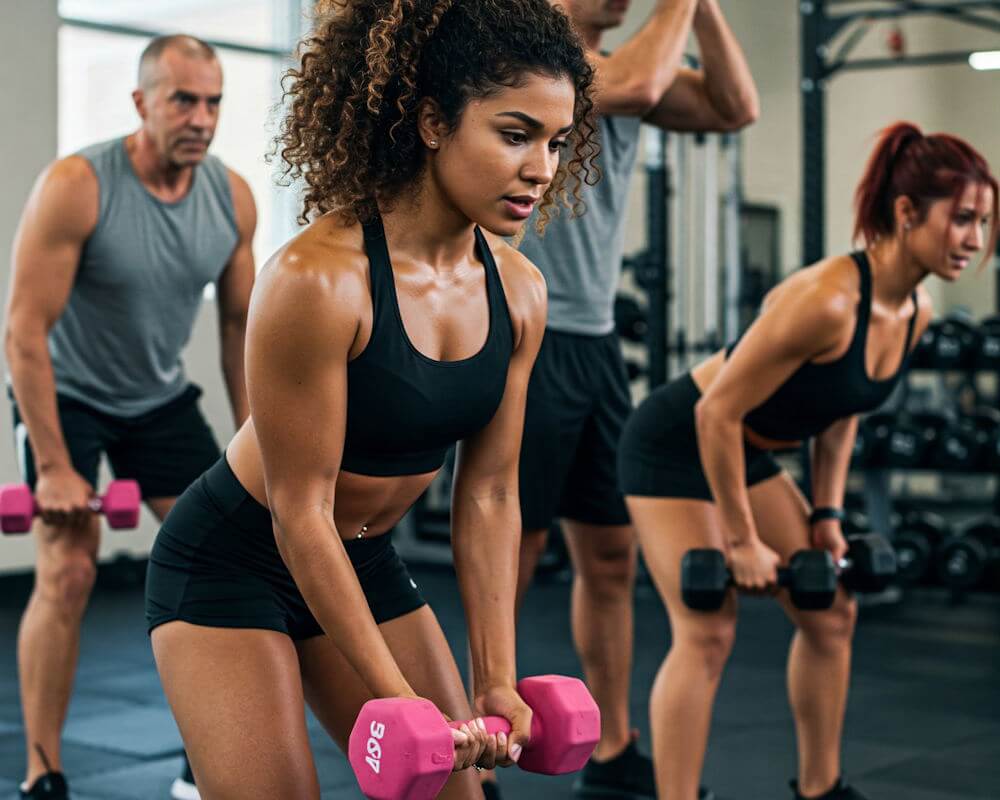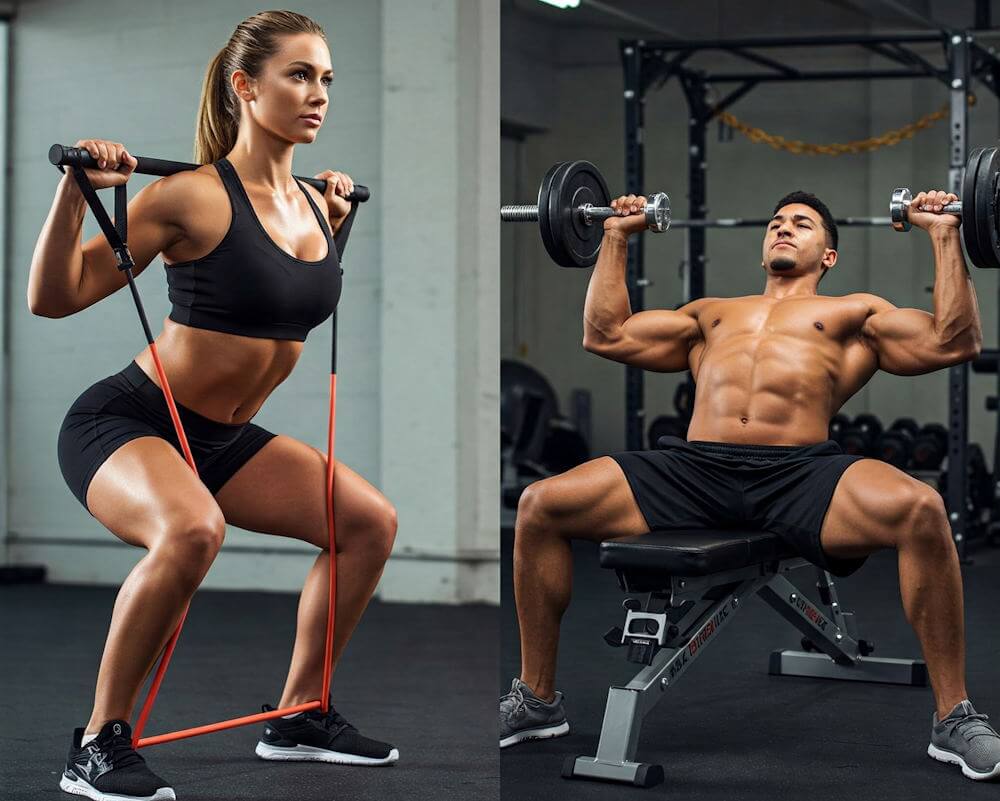Dumbbell workouts are a form of strength training that utilizes dumbbells as primary equipment. These compact weights offer a versatile option for individuals looking to enhance their fitness levels without being confined to a gym. The unique design of dumbbells allows for a diverse range of exercises, enabling users to target various muscle groups effectively. As a result, they serve as an excellent tool for building strength and toning muscles.
One of the primary benefits of incorporating dumbbells into a workout routine is their convenience. Unlike larger gym equipment, dumbbells can easily fit into a personal space, whether at home, in a park, or on vacation. This portability empowers individuals to maintain their fitness regimens regardless of their location, making it simpler to integrate exercise into daily life. This adaptability is particularly appealing for those with busy schedules or frequent travelers.
Moreover, dumbbell workouts offer the flexibility to engage multiple muscle groups simultaneously. Whether performing compound movements such as dumbbell squats or isolating specific areas like biceps or triceps, these weights provide the necessary resistance to stimulate muscle growth effectively. By adjusting the weight and varying exercise routines, users can continuously challenge themselves and progress at their own pace. This leads to enhanced muscular endurance and overall body strength.
The ability to incorporate dumbbells into both home and outdoor fitness routines further accentuates their appeal. As outdoor workouts gain popularity, the ease of carrying a set of dumbbells allows enthusiasts to break free from traditional gym settings. Whether in a backyard, a local park, or even during a vacation, individuals can enjoy tailored strength training sessions that contribute to their fitness goals.
The Benefits of Dumbbell Workouts
Dumbbell workouts offer a multitude of benefits that make them an appealing choice for fitness enthusiasts at various levels. One of the primary advantages is improved muscle strength. By utilizing dumbbells, individuals can target specific muscle groups more effectively than with bodyweight exercises alone. This targeted approach helps in building strength, enhancing overall physical performance, and contributing to daily functional movements.
Furthermore, dumbbell exercises promote increased flexibility. Many dumbbell movements require a full range of motion, which encourages joint mobility and muscle elasticity. This is particularly beneficial for those who engage in activities requiring flexibility or who wish to prevent injuries associated with stiffness. As users progress and adapt, they can gradually increase weights, leading to significant improvements in flexibility and overall mobility.
Cardiovascular health is another crucial aspect addressed through dumbbell workouts. When exercises are performed in a circuit format or with high intensity, they can elevate heart rates, thus providing cardiovascular benefits alongside strength training. This dual action not only enhances endurance but also aids in weight management, concluding in a more balanced fitness regimen.
Moreover, dumbbell workouts promote core stability and balance. Exercises such as single-arm rows or overhead presses require engagement of the core, forcing stabilization during the movement. This engagement strengthens the abdominal and lower back muscles, leading to improved posture and reduced risk of injury during daily activities.
Additionally, dumbbells are versatile and accessible, allowing individuals to tailor their workouts to meet various fitness goals, be it muscle building, toning, or endurance training. This adaptability makes dumbbell workouts suitable for beginners and seasoned athletes alike, facilitating a progressive approach to fitness that can evolve over time.
Essential Dumbbell Exercises for Beginners
For those beginning their fitness journey, incorporating dumbbell exercises into your routine can be remarkably beneficial. Dumbbells provide a versatile way to engage multiple muscle groups, enhancing strength, coordination, and balance. Below are three essential dumbbell exercises ideal for novices, each designed to be performed with proper form and technique.
The first exercise is the **dumbbell squat**. To execute this fundamental movement, hold a dumbbell in each hand at shoulder height, with your elbows tucked in close. Stand with your feet shoulder-width apart. Initiate the squat by pushing your hips back and bending your knees, ensuring your chest remains upright and your back straight. Lower your body until your thighs are parallel to the floor, then return to the starting position. The dumbbell squat primarily targets the quadriceps, hamstrings, and glutes, and enhances overall leg strength.
Next, we have the **dumbbell press**, which can be performed either standing or seated. Begin with a dumbbell in each hand at shoulder level, palms facing forward. As you press the weights overhead, engage your core and maintain a neutral spine. Ensure that your elbows do not extend too far forward or backward, to avoid unnecessary strain. This exercise works the shoulders, triceps, and upper chest. Begin with lighter weights to master the technique before progressing to heavier loads.
Lastly, the **dumbbell rows** are an effective exercise for strengthening the back muscles. To perform a dumbbell row, bend forward at the waist while keeping your knees slightly bent. With a dumbbell in each hand, pull the weights toward your torso, focusing on squeezing your shoulder blades together. Proper form is crucial; ensure that your spine remains neutral throughout the movement. This exercise primarily targets the latissimus dorsi, trapezius, and rhomboids.
Incorporating these essential dumbbell exercises into your routine can build a strong foundation for your fitness journey, enabling you to work safely and effectively towards your strength goals.
Intermediate Dumbbell Workout Routines
Intermediate dumbbell workout routines offer a diverse approach to enhancing overall fitness through compound movements that engage multiple muscle groups simultaneously. These workouts allow individuals to introduce progression and complexity to their training regimen, harnessing the benefits of dumbbells that can conveniently be utilized in various environments. The following routines are designed to target different muscle groups while promoting hypertrophy and strength development through progressive overload techniques.
A well-structured week of training can include four focused sessions, each with distinct goals. For example, the first day could concentrate on upper body strength, combining exercises such as the dumbbell bench press and bent-over rows. These exercises, when performed in a superset format, not only enhance muscle endurance but also allow for increased time efficiency. Each exercise should aim for 8 to 12 repetitions, encouraging lifters to gradually increase the weight of the dumbbells as they progress.
The second session may revolve around lower body workouts, incorporating movements such as goblet squats and lunges. These complex exercises stimulate major muscle groups in the legs, and utilizing different variations — such as forward, reverse, or lateral lunges — allows for a comprehensive lower body regimen. Again, a focus on 8 to 12 repetitions coupled with gradual weight increases ensures continued progression.
The mid-week workout can be mixed, including core activation exercises like Russian twists combined with shoulder presses. This combination not only focuses on stability but also maximizes efficiency by engaging the shoulder and core simultaneously. Lastly, a cardio and core session could be introduced, utilizing dumbbell swings and mountain climbers to boost heart rate while strengthening the abdominal muscles.
By varying these workouts throughout the week and emphasizing compound movements, practitioners can enhance their strength and fitness levels, making the most out of their intermediate dumbbell workout journey. These routines not only keep the training engaging but also ensure that individuals can effectively adapt their workouts to fit their personal fitness goals.
Advanced Dumbbell Workouts for Power and Endurance
For fitness enthusiasts seeking to elevate their strength training, advanced dumbbell workouts provide a means to increase both power and endurance through high-intensity techniques and circuit-style routines. Incorporating advanced exercises, such as the single-arm dumbbell snatch, Bulgarian split squats, and plyometric movements, can significantly challenge experienced users and enhance their workout efficacy.
The single-arm dumbbell snatch is a dynamic exercise that not only builds explosive strength but also engages multiple muscle groups, including the shoulders, back, and legs. To perform this movement, begin with a dumbbell placed on the floor between your feet. With a powerful movement, lift the dumbbell from a squat position, driving through your legs and extending your hips and arm upwards in one fluid motion. This exercise promotes coordination, stability, and overall body power.
Another potent addition to any advanced routine is the Bulgarian split squat. This lower-body movement targets the quads, hamstrings, and glutes while also requiring core engagement for stabilization. To execute, position one foot on an elevated surface behind you while standing with the other foot forward. Lower your body into a squat, ensuring the front knee does not extend past the toes. This form not only builds strength but also improves balance and endurance over time.
Plyometric movements involving dumbbells, such as dumbbell jump squats, are equally effective for enhancing power and endurance. By incorporating explosive movements into your routine, you can improve athletic performance and cardiovascular capacity. A proper jump squat entails holding dumbbells at your sides, squatting down and then explosively jumping upwards, landing softly to reset for the next repetition. This technique not only builds strength but also fosters agility and explosiveness.
These advanced dumbbell workouts, emphasizing exercises like the single-arm dumbbell snatch, Bulgarian split squats, and plyometric movements, can greatly contribute to achieving superior levels of strength and endurance. Integrating these high-intensity techniques will enhance overall fitness and prepare you for a range of physical challenges.
Tips for Choosing the Right Dumbbells
When selecting the appropriate dumbbells for your fitness journey, several factors must be considered to ensure they align with your personal needs and goals. One of the first aspects to evaluate is the weight options available. Dumbbells generally come in a variety of weights, ranging from light to heavy, which allows users to increase resistance as strength improves. It is crucial to choose weights that challenge you without compromising your form, especially if you are new to strength training.
Another significant decision is whether to opt for adjustable or fixed weights. Adjustable dumbbells are versatile, allowing users to modify the weight according to their routines. This flexibility is ideal for individuals who may have limited storage space or those who engage in diverse exercises requiring varying weights. Conversely, fixed weights can provide ease of use, as they are often more straightforward and convenient for quick workouts, albeit they would require more physical space if one intends to possess multiple weights.
Additionally, consider the ergonomic design of dumbbells. It is essential that the grip feels comfortable during your workouts, helping to reduce the risk of injury. Look for models with non-slip surfaces and a shape that fits comfortably in your hand. The right design not only enhances grip but can also facilitate more effective exercise execution.
When planning your dumbbell workouts, think about where you will primarily use them—at home or in a gym setting. For home use, adjustable dumbbells could be more practical, while a gym environment may have a broader range of fixed weight options available for use. Taking these factors into account will not only enhance your training experience but also help you achieve your desired fitness outcomes.
Creating Your Own Dumbbell Workout Plan
Designing a custom dumbbell workout plan allows you to effectively integrate fitness into your busy lifestyle while addressing your individual needs and goals. To start, assess your current fitness level and define your objectives—whether improving strength, enhancing endurance, or working towards weight loss. Once your goals are clear, you can create a weekly schedule that fits seamlessly into your daily routine.
A well-structured plan typically involves exercising three to five times a week, allowing for various muscle groups to be targeted each day. For example, you might dedicate Mondays and Thursdays to upper body workouts, such as dumbbell presses and rows, while using Tuesdays and Fridays for lower body exercises like squats and lunges. This split helps balance muscle engagement and reduces the risk of overtraining. Ensuring that you alternate muscle groups also gives increased focus to recovery periods, which is crucial for muscle growth and performance improvement.
Moreover, rest days are essential in any effective workout routine. They enable your muscles to recover and grow stronger, preventing burnout and sustaining motivation. You might incorporate active recovery days, where you engage in light activities such as walking or yoga, keeping your body moving while allowing it time to recuperate. Rest is not merely the absence of activity; it is an integral part of achieving your fitness goals.
Mixing and matching different dumbbell exercises can provide a comprehensive workout regimen. Consider combining compound movements, like deadlifts and bench presses, with isolation exercises such as bicep curls or tricep extensions. This not only helps in targeting specific muscle groups but enhances overall functionality and performance. Tailoring your dumbbell workout plan in this way encourages diversity, making your fitness journey both effective and enjoyable.
Warm-Up and Cool-Down Techniques
Incorporating proper warm-up and cool-down techniques is essential for maximizing performance and minimizing the risk of injury during your dumbbell workouts. A well-structured warm-up prepares the body for physical activity, increases blood flow to muscles, and enhances overall flexibility. Conversely, a cool-down routine helps the body gradually transition back to a resting state, facilitates recovery, and reduces muscle soreness.
A good warm-up should last approximately 5 to 10 minutes and involve dynamic movements that emphasize the muscle groups you intend to work. Exercises such as arm circles, leg swings, and torso twists are effective for increasing mobility. Additionally, light aerobic activities, like jogging in place or brisk walking, can enhance heart rate and circulation. Incorporating specific mobility exercises targeting the hips, shoulders, and ankles can further prepare your body for the intensity of your dumbbell workout.
As you prepare for your session, consider performing movements that mimic the lifts you plan to execute with the dumbbells. For example, if you’ll be doing a dumbbell squat, integrate a bodyweight squat into your warm-up. This specific approach to warming up helps prime the muscles for the activities they will be engaged in, thereby improving performance and safety.
Post-workout cool-downs should also last around 5 to 10 minutes, focusing on static stretching and relaxation exercises. Moreover, stretching major muscle groups used during your workout can aid in maintaining flexibility and alleviating tension. Consider hamstring stretches, quadriceps stretches, and shoulder stretches as part of your regimen. Deep breathing exercises can also be beneficial, promoting relaxation and facilitating a smooth transition from high-intensity activity to rest.
By implementing both warm-up and cool-down techniques into your dumbbell workouts, you not only promote optimal performance but also foster long-term exercise adherence and overall fitness. Adhering to these practices can significantly enhance your workout’s effectiveness while mitigating injury risks.
Final Thoughts: Making Dumbbell Workouts a Lifestyle
Incorporating dumbbell workouts into daily routines can profoundly impact overall health and wellness. Establishing a consistent fitness regimen centered around dumbbells offers numerous advantages, including improved strength, flexibility, and endurance. By prioritizing dumbbell exercises, individuals can build a strong foundation that supports both physical and mental well-being, ultimately transforming their lifestyle.
One crucial aspect of making these workouts a long-term commitment is cultivating a mindset of consistency. Regularly engaging in dumbbell exercises not only enhances physical appearance but also fosters a sense of accomplishment and motivation. Setting realistic and attainable fitness goals helps in maintaining a positive outlook. It is essential to recognize that progress might take time, and celebrating small victories along the way can significantly bolster motivation. Rather than focusing on immediate outcomes, it is beneficial to concentrate on the journey towards long-term fitness.
Exploring different environments for dumbbell workouts can further enrich this experience. Whether at home, in a park, or while traveling, the versatility of dumbbells allows for a variety of workout settings. Discovering new locations can make workouts feel less routine and more enjoyable. Engaging with different communities or fitness groups can also enhance motivation, as individuals can share experiences, tips, and encouragement. Ultimately, the key to integrating dumbbell workouts into one’s lifestyle lies in the commitment to consistency, exploration, and setting achievable fitness objectives.
Adopting dumbbell workouts as a regular practice not only empowers individuals to stay fit on the go, but also supports a healthier life overall. By making the conscious decision to incorporate these exercises into daily routines, one can pave the way for a sustainable and fulfilling fitness journey.



